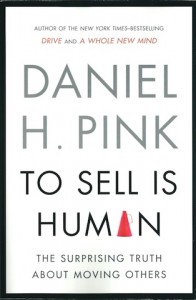The one-sentence summary
Selling is no longer solely the domain of salespeople, because we are all trying to move each other in some way or another.
WHAT THE BOOK SAYS 
• One in nine Americans work in sales, but so do the other eight. We are all in sales now – trying to ‘move’ others to our point of view.
• ‘Non-sales selling’ involves persuading or convincing others to give up something they’ve got in exchange for what we’ve got, and we now spend 40% of our time doing it.
• The forces behind this are:
1. Entrepreneurship: ironically fuelled by the very technologies that were supposed to destroy salespeople (so-called ‘disintermediation’ never happened.
2. Elasticity: most of our skills now stretch across many boundaries
3. Ed-Med: the fastest growing industries around the world are education and healthcare – both require constant selling
• The old asymmetry, whereby the salesperson knew more than the customer, no longer applies. Instead of caveat emptor, it is now a case of caveat venditor – seller beware.
• The ABC of moving others is no longer ‘Always Be Closing’ – it’s now:
Attunement: being in harmony with groups, individuals, and contexts (taking another person’s perspective)
Buoyancy: grittiness of spirit and ‘sunniness’ of outlook equals resilience
Clarity: finding problems and defining them to make sense of murky situations is more important then just solving them
• There are many facets to achieving these qualities, including ‘interrogative self-talk’ (talking to yourself in a motivating way), drawing discussion maps to see who is talking and listening most, and finding genuine problems to solve rather than just solving what’s in front of you.
WHAT’S GOOD ABOUT IT
• If you want to succeed at sales, you need to pitch, be prepared to improvise, and serve (you are serving your customer).
• Pitch techniques include: reduce the thought to one word; pose a question; make the theme rhyme (it’s more memorable); state it in under 140 characters (like Twitter).
• Try the “Pixar pitch” (named after the animation company), by telling your story in this formula: “Once upon a time A. Every day B. One day C. Because of that D. Because of that E. Until finally F.”
• The best salespeople are neither extraverts nor introverts – they are ambiverts* – a bit of each. *This is not a made up word – it has been in the literature since the 1920s.
• To understand a complex sales situation, you need to envisage a mental map of all those involved – a form of social cartography.
• A good way to dramatise this is to use Jeff Bezos’s “Pull up a chair” philosophy – he insists on having an empty chair at every meeting to remind everyone what the customer view might be.
• The way things are framed influences the likelihood of a sale: try offering less, labelling options differently, pointing out the pitfalls rather than just the benefits, explaining the potential, and offering an easy launch pad to get the thing done (something the author calls an ‘off-ramp’).
• Good selling involves agitation rather than irritation – identify the 1% question that’s important, and the rest will fall into place.
WHAT YOU HAVE TO WATCH
• Nothing. It’s a really good read – succinct, lucid, and well-researched.
